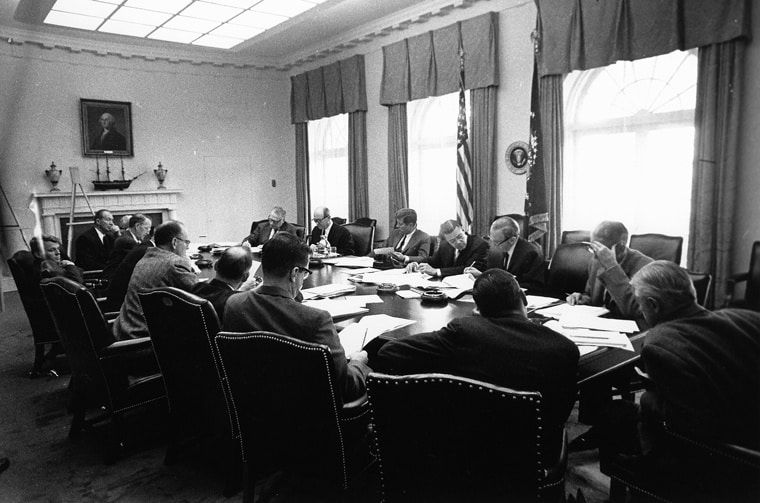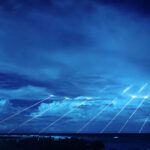Déjà vu and nuclear roulette: The Bulletin’s initial reactions to the Cuban Missile Crisis
By David A. Wargowski | October 26, 2022
 An October 29, 1962 Executive Committee of the National Security Council. Clockwise from President Kennedy: President Kennedy; Secretary of Defense Robert S. McNamara; Deputy Secretary of Defense Roswell Gilpatric; Chairman of the Joint Chiefs of Staff Gen. Maxwell Taylor; Assistant Secretary of Defense Paul Nitze; Deputy USIA Director Donald Wilson; Special Counsel Theodore Sorensen; Special Assistant McGeorge Bundy; Secretary of the Treasury Douglas Dillon; Attorney General Robert F. Kennedy; Vice President Lyndon B. Johnson (hidden); Ambassador Llewellyn Thompson; Arms Control and Disarmament Agency Director William C. Foster; CIA Director John McCone (hidden); Under Secretary of State George Ball; Secretary of State Dean Rusk.
Photograph by Cecil Stoughton, White House, in the John F. Kennedy Presidential Library and Museum.
An October 29, 1962 Executive Committee of the National Security Council. Clockwise from President Kennedy: President Kennedy; Secretary of Defense Robert S. McNamara; Deputy Secretary of Defense Roswell Gilpatric; Chairman of the Joint Chiefs of Staff Gen. Maxwell Taylor; Assistant Secretary of Defense Paul Nitze; Deputy USIA Director Donald Wilson; Special Counsel Theodore Sorensen; Special Assistant McGeorge Bundy; Secretary of the Treasury Douglas Dillon; Attorney General Robert F. Kennedy; Vice President Lyndon B. Johnson (hidden); Ambassador Llewellyn Thompson; Arms Control and Disarmament Agency Director William C. Foster; CIA Director John McCone (hidden); Under Secretary of State George Ball; Secretary of State Dean Rusk.
Photograph by Cecil Stoughton, White House, in the John F. Kennedy Presidential Library and Museum.
Russia’s invasion of Ukraine and its nuclear saber-rattling have roused the nuclear war genie, with the word “Armageddon” creeping into general discussion during the 60th anniversary of the Cuban Missile Crisis. That 35-day crisis (Oct. 16–Nov. 20, 1962) remains a definitive moment in United States national security history and was the general public’s first up-close-and-personal introduction to the real possibility of nuclear war. To those of us who witnessed this crisis, the days were long, nervous, and doomy. Many books have been published since the Cuban Missile Crisis. Thirteen Days by Robert F. Kennedy (1969), High Noon in the Cold War by Max Frankel (2004), and One Minute to Midnight by Michael Dobbs (2008) are among the most prominent. The crisis also has spawned numerous films, seminars, white papers, and panel discussions.
But the initial editorials of the Bulletin of the Atomic Scientists regarding the Cuban Missile Crisis, published from December 1962 to February 1963, provide a remarkable window into the immediate reaction to the real possibility of Doomsday:
- Guest Editorial: The Twentieth Year by Harrison Brown. December 1962, pages 2-3
- New Year’s Thoughts 1963 by Eugene Rabinowitch. January 1963, page 2
- Disarmament after Cuba by David R. Inglis. January 1963, pages 18-21.
- After Cuba: Two Lessons by Eugene Rabinowitch. February 1963, pages 2-8.
- Military Value of Missiles in Cuba by Roger Hagan and Bart Bernstein. February 1963, pages 8-13.
All of these editorials provide historical perspective on the views of prominent and soon-to-be prominent nuclear minds of the early 1960s, as they grappled with the possibility of the end of civilization. However, one commentary is worth special attention.
Harrison Brown started writing his guest editorial “The Twentieth Year” on October 24, 1962, during the height of the Cuban Missile Crisis. The first paragraph of his editorial is profound and relevant; its message is as meaningful today as it was 60 years ago. The editorial begins:
OCTOBER 24, 1962: I am writing on a plane en route from Los Angeles to Washington and for all I know this editorial, honoring the twentieth anniversary of the first controlled release of nuclear energy by man, may never be published. This morning, the governments of the United States and Soviet Union were moving relentlessly toward armed conflict in the Caribbean. Missiles and planes stand poised on both sides, ready to deliver their deadly weapons to their targets. By tomorrow, if inflexibility persists or if someone in the Soviet Union or in Cuba or in our own government makes the wrong decision, the great all-out nuclear war, which we have discussed and feared for twenty years, may be triggered. Never in History have people and nations been so close to death and destruction on such a vast scale. Midnight is upon us.
Despite its age, Harrison Brown’s guest editorial continues to serve as a wake-up call. At the time it was published, the Doomsday Clock was set at seven minutes to midnight. In 2022, the Doomsday Clock sits at 100 seconds to midnight, where it has lingered since 2020. We must take Harrison Brown’s 1962 wake-up call seriously. Future generations should be allowed to read it again 60-years from now, in a world that has learned its lesson about nuclear weapons through diplomacy, awareness of the scope of the nuclear threat, and elimination, rather than the annihilation that seemed so palpable in 1962.
Together, we make the world safer.
The Bulletin elevates expert voices above the noise. But as an independent nonprofit organization, our operations depend on the support of readers like you. Help us continue to deliver quality journalism that holds leaders accountable. Your support of our work at any level is important. In return, we promise our coverage will be understandable, influential, vigilant, solution-oriented, and fair-minded. Together we can make a difference.
Keywords: Cuban Missile Crisis, Doomsday Clock, Eugene Rabinowitch, Harrison Brown
Topics: Nuclear Risk, Nuclear Weapons















